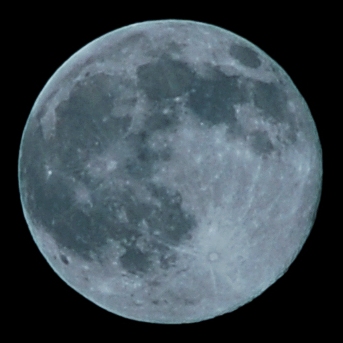There was a full moon on August 1, 2012, and today, August 31, marks the second full moon of the month. Using the commonly accepted calendar definition of a Blue Moon, tonight’s moon will be the last Blue Moon for nearly three years, as the next one won’t happen until 2015. But if you side with the Farmers’ Almanac definition of a Blue Moon, the next one won’t happen until 2016.
No matter which definition you ascribe to, Blue Moons happen because the lunar month, which is always about 29-1/2 days, don’t exactly match up with our Gregorian calendar months, which vary from 29 to 31 days. (I still have to count knuckles.) Confused? Here’s a brief explanation.
In the English language, the earliest recorded uses of the term “blue moon” had religious connotations, but the 19th and early 20th century history of the term is a bit closer at hand.
Farmers’ Almanac Blue Moon
The four seasons–spring, summer, fall, and winter–divide the year into quarters, and each season usually has three full moons. Ancient cultures around the world have always named each of the full moons. Farmers’ lives are dictated by the passing of each successive season, and in North America, the farmers have names for every season’s full moons, too.
- Spring starts on the Vernal Equinox
- Early Spring, or Egg Moon
- Mid Spring, or Milk Moon
- Late Spring, or Flower Moon
- Summer starts on the Summer Solstice
- Early Summer, or Hay Moon
- Mid Summer, or Grain Moon
- Late Summer, or Fruit Moon
- Fall starts on the Autumnal Equinox
- Early Fall, or Harvest Moon
- Mid Fall, or Hunter’s Moon
- Late Fall, or Oak Moon
- Winter starts on the Winter Solstice
- Early Winter, or Old Moon
- Mid Winter, or Wolf Moon
- Late Winter, or Lenten Moon
But very little in a farmer’s life is ever easy. Because of the difference in length of the almost uniform lunar month and the varying lengths of our Gregorian calendar months, a fourth full moon creeps into one of the seasons, every once in a . . . while. These absurd, extra full moons threatened to disrupt the farmers’ meaningful “early-mid-late” naming convention, but by necessity, farmers are very resourceful folks. So any time a season had four full moons, the THIRD one was called a Blue Moon, so the last full moon of that season could continue to be called the Late Moon. In the 19th and early 20th centuries, the Maine Farmers’ Almanac always listed blue moon dates for farmers.
Calendar Blue Moon
Don’t worry, this is a much shorter explanation.
In 1946, in an article he wrote for Sky and Telescope magazine, James Pruett misinterpreted the 1937 Maine Farmers’ Almanac, which described years with blue moons as having “… eleven months with one full moon each and one with two.” Pruett wrote that he interpreted this to mean the second full moon in any given month was a Blue Moon. This “non-traditional” definition became widely adopted when it was broadcast on a popular radio program in 1980. Don’t believe everything you read on the Internet, either.
By the way, a Blue Moon isn’t really blue. Today, the phrase “Once in a Blue Moon” is taken to relate to absurdities, impossibilities, and events that only occur on rare occasions.

August 25, 2012 marked the passing of Neil Armstrong, a truly great American and a boyhood hero of mine. Neil’s family issued a statement shortly after his death:
“For those who may ask what they can do to honor Neil, we have a simple request. Honor his example of service, accomplishment and modesty, and the next time you walk outside on a clear night and see the moon smiling down at you, think of Neil Armstrong … and give him a wink.”
The Family of Neil Armstrong
I will never be able to look up at the moon again–whether it be an Egg Moon, a Harvest Moon, a Lenten Moon, or a Blue Moon like tonight’s–and not give Neil a thought, a thanks, and a wink.

Comments
One response to “Once in a Blue Moon”
Reblogged this on The Linden Chronicles and commented:
Great information about the upcoming “Wolf Moon” Cycle.